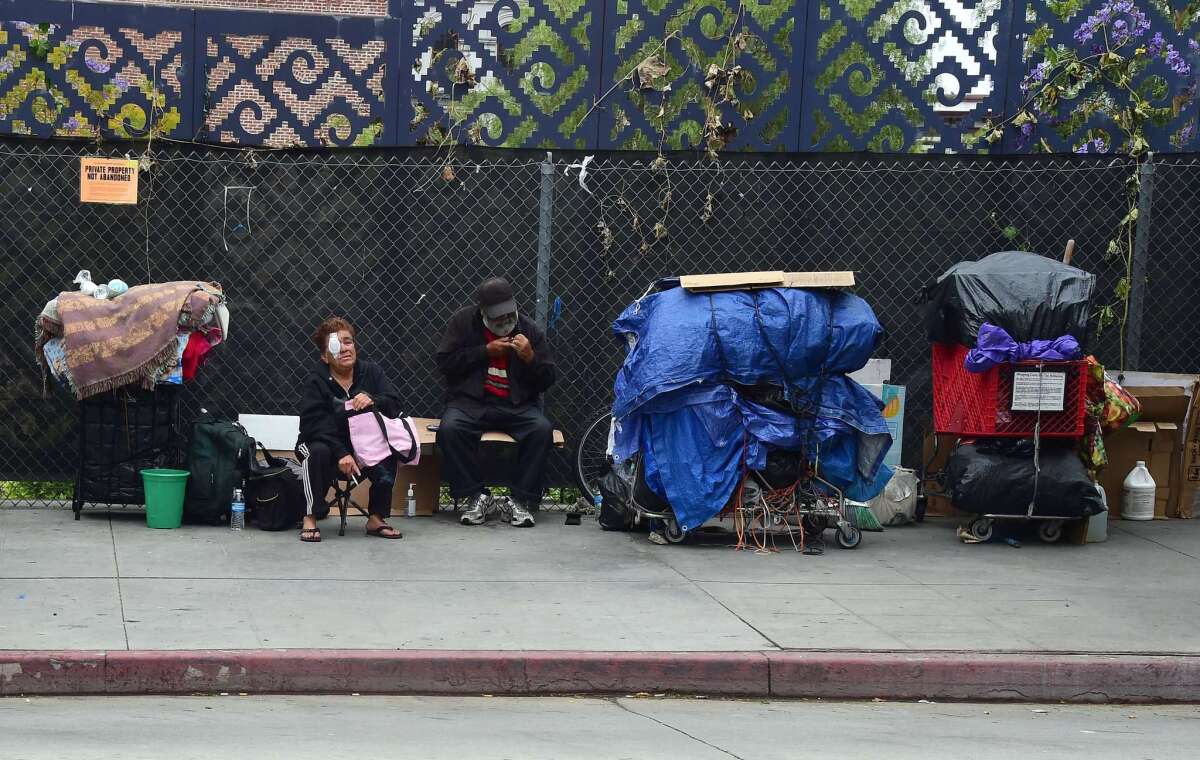Op-Ed: ‘Housing first’: What L.A. can learn from Utah on homelessness

Homeless residents sit with their belongings in downtown L.A. on May 12. A report released by the Los Angeles Homeless Services Authority showed an increase in the homeless population in much of L.A. County.
- Share via
Sam has been living in an encampment under the 101 Freeway for the last six years. He is 63, has a bad heart and drinks a lot. He came to Los Angeles from Utah, where he became homeless at age 50 after losing his job. If he’d chosen to stay put, he’d probably be better off.
Utah announced recently that, in the last 10 years, it has successfully housed 91% of its chronically homeless population: 1,764 out of 1,932 people. There are now fewer than 200 chronically homeless people in the entire state. By contrast, Los Angeles County’s chronically homeless population rose from 7,475 in 2013 to 12,356 this year, according to the latest estimate.
Although the scale of the problem in Utah is obviously much smaller than it is here, Los Angeles could learn from that state’s dogged implementation of a “housing first” policy — which, as the name suggests, prioritizes getting people off the streets and into permanent supportive housing. Homeless individuals don’t have to participate in drug recovery or mental health treatment to qualify for a subsidized apartment.
Housing first is actually considered best practice in Los Angeles as well. Throughout the county a coordinated entry system has been implemented to match the most vulnerable people to suitable shelter. And since 2011, the county has housed 7,269 chronically homeless people — a significant achievement. The problem is that the county doesn’t commit the housing resources necessary to meet the need. The entry system is clogged at the front door.
L.A. County is one of the most expensive rental markets in the United States. Our 44,359 homeless individuals and families compete for the same accommodations as the 1.5 million low-income households that are on the brink of homelessness because they cannot afford rental prices.
Even if you are one of the very fortunate few who qualify for and receive a housing voucher, most rental units are still out of reach, either because they’re too costly (beyond the limits of the voucher) or because the landlord refuses to accept vouchers.
Some treat the housing shortage as if it were a fact of nature; others argue that there is no money to build or rehabilitate the housing we need — but that’s because we waste money on efforts to manage homelessness rather than end it.
The city of Los Angeles has increased the number of anti-homeless laws on the books by 59% since 1990. There are now 23 restrictions and 19 laws that criminalize homelessness in some way. Each year, the city spends $80 million enforcing these rules — containing, moving and jailing people who have no choice but to sleep, stand and eat in public.
If the city used that $80 million on housing, it would almost certainly save money in the long run. According to a report in this paper, “The cost of providing an apartment and social work for clients in [Utah’s] Housing First program is $11,000 annually, while the average price of hospital visits and jail for street denizens is nearly $17,000 a year.”
Even as L.A. punishes the homeless, it does little to prevent homelessness in the first place. Too often we define the cause of homelessness as mental illness or addiction. Actually the cause is untreated mental illness or addiction. Poor people in Los Angeles have minimal access to behavioral health treatment or recovery services. Until these systems effectively address their needs, the homeless population will continue to grow.
Yet another problem is the lack of support for those who pass through our criminal justice system. There’s an emerging national movement to bring down incarceration rates, but there are few plans for what to do with the many people released from prison with nowhere to go. Those who already have a criminal record face immense difficulties in obtaining housing, employment and basic benefits such as food stamps. It’s no wonder many of them end up homeless.
One out of every 226 people in L.A. County is homeless. That’s an epidemic, not just a crisis. Thousands are living in extreme poverty, on our public sidewalks, exposed every day to trauma and abuse. Utah has proved that it’s possible to end chronic homelessness. Los Angeles can do the same, if we’re ready to rethink how we deploy our resources.
Mollie Lowery is executive director for Housing Works and a longtime advocate for the homeless.
Follow the Opinion section on Twitter @latimesopinion and Facebook
More to Read
Sign up for Essential California
The most important California stories and recommendations in your inbox every morning.
You may occasionally receive promotional content from the Los Angeles Times.










